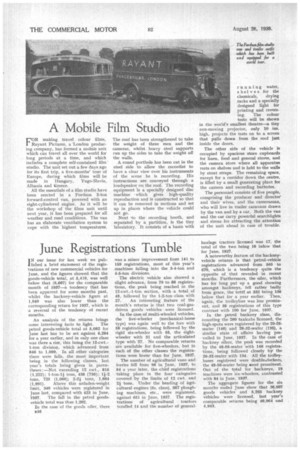June Registrations Tumble
Page 50

If you've noticed an error in this article please click here to report it so we can fix it.
I N our issue for last week we pub/fished a brief statement of the registrations of new commercial vehicles for June, and the figures showed that the goods-vehicle total, at 5,419, was well below that (6,607) for the comparable month of 1937—a tendency that has been apparent for some months past, whilst the hackney-vehicle figure at 1,040 was also lower than the corresponding return for 1937, which is a reversal of the tendency of recent months.
An analysis of the returns brings some interesting facts to light. The petrol goods-vehicle total at 5,082 for June last has to be set against 6,284 for a year earlier, and in only one class was there a rise, this being the 12-cwt.1-ton division, which advanced from 846 to 1,099. In all other categories there were falls, the most important being in the following classes, last year's totals being given in parentheses : —Not exceeding 12 cwt., 816 (1,222); 1-ton-lf tons, 438 (736); 1f-2 tons, 725 (1,066); 2-21 tons, 1,664 (1,991). Above this unladen-weight limit, 340 vehicles were registered in June last, compared with 423 in June, 1937. The fall in the petrol goodsvehicle total was thus 1,202. In the case of the goods oiler, there E16 was a minor improvement from 141 to 159 registrations, most of this year's machines falling into the 3-4-ton and 4-5-ton divisions.
The electric vehicle also showed a slight advance, from 79 to 88 registrations, the peak being reached in the 12-cwta1-ton section, with a total of 48, followed by the I-2-ton class with 27. An interesting' feature of the month's returns is that two coal-gasdriven goods vehicles were licensed. In the case of multi-wheeled vehicles, the five-wheeler (mechanical-horse type) was again well to the fore with 58 registrations, being followed by the rigid six-wheeler with 55, the eightwheeler with 31 and the articulated type with 27. No comparable returns are available for five-wheelers, but in each of the other classes the registrations were lower than for June. 1937. The number of agricultural vans and lorries fell from 96 in June. 1937, to 84 a year later, the chief registrations taking place in the four categories covered by the limits of 12 cwt. and 2f tons. Under the heading of agricultural engines (5s. class), 387 ploughing machines, etc., were registered, against 651 in June, 1937. The registrations of agricultural tractors totalled 14 and the number of general haulage tractors licensed was 17, the total of the two being 10 below that for June, 1937. A noteworthy feature of the hackneyvehicle returns is that petrol-vehicle registrations advanced from 565 to 670, which is a tendency quite the opposite of that revealed in recent months. Furthermore, the oiler, which has for long put up a good showing amongst hackneys, fell rather badly from grace, the total at 332 being 136 below that for a year earlier. Then, again, the trolleybus was less prominent, and 38 registrations of this type contrast with 100 for June, 1937. In the petrol hackney Hass, discounting the 260 taxicabs licensed, the high-spots were registered by the 20-26seater (146) and 26-32-seater (135), a similar state of affairs having prevailed in June, 1937. In the case of hackney oilers, the peak was recorded by the 48-56-seater with 146 registrations, being followed closely by the 26-32-seater with 134. All the trolleybuses registered were doublealeckers, the 48-56-seater being most prominent. Out of the total for hackneys, 19 machines were six-wheelers, contrasted with 84 in June, 1937. The aggregate figures for the six months ended June show that 36,307 goods vehicles and 5,265 hackney vehicles were licensed, last year's comparable returns being 40,964 and 4,943.




















































































